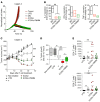Single residue in CD28-costimulated CAR-T cells limits long-term persistence and antitumor durability
- PMID: 32069268
- PMCID: PMC7260017
- DOI: 10.1172/JCI133215
Single residue in CD28-costimulated CAR-T cells limits long-term persistence and antitumor durability
Abstract
Chimeric antigen receptor-T (CAR-T) cell therapies can eliminate relapsed and refractory tumors, but the durability of antitumor activity requires in vivo persistence. Differential signaling through the CAR costimulatory domain can alter the T cell metabolism, memory differentiation, and influence long-term persistence. CAR-T cells costimulated with 4-1BB or ICOS persist in xenograft models but those constructed with CD28 exhibit rapid clearance. Here, we show that a single amino acid residue in CD28 drove T cell exhaustion and hindered the persistence of CD28-based CAR-T cells and changing this asparagine to phenylalanine (CD28-YMFM) promoted durable antitumor control. In addition, CD28-YMFM CAR-T cells exhibited reduced T cell differentiation and exhaustion as well as increased skewing toward Th17 cells. Reciprocal modification of ICOS-containing CAR-T cells abolished in vivo persistence and antitumor activity. This finding suggests modifications to the costimulatory domains of CAR-T cells can enable longer persistence and thereby improve antitumor response.
Keywords: Cancer immunotherapy; Immunology; T cells; Therapeutics.
Conflict of interest statement
Figures





Comment in
-
Replacing CAR-T cell resistance with persistence by changing a single residue.J Clin Invest. 2020 Jun 1;130(6):2806-2808. doi: 10.1172/JCI136872. J Clin Invest. 2020. PMID: 32364534 Free PMC article.
References
Publication types
MeSH terms
Substances
Grants and funding
LinkOut - more resources
Full Text Sources
Other Literature Sources
Medical
Molecular Biology Databases
Research Materials

